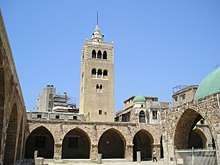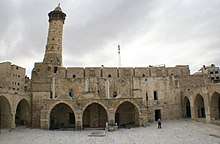Mamluk architecture
Mamluk architecture was a flowering of Islamic art during the reign of the Mamluk Sultanate (1250–1517), which is most visible in medieval Cairo. Religious zeal made them generous patrons of architecture and art. Trade and agriculture flourished under Mamluk rule, and Cairo, their capital, became one of the wealthiest cities in the Near East and the center of artistic and intellectual activity. And as described in the words of Ibn Khaldun, "Cairo is the center of the universe and the garden of the world", with majestic domes, courtyards, and soaring minarets spread across the city.
|
|
|
|
|
|
Contributors
The architectural identity of Mamluk era Islamic religious monuments stems from the major purpose that individuals erected their own memorials, therefore adding a high degree of individuality. Each building reflected the patron's individual tastes, choices, and name. Mamluk Islamic architecture is oftentimes categorized more by the reigns of the major sultan, than a specific design. The elite were often more knowledgeable in the art of buildings than many historians.[1]
Since the rulers had both wealth and power, the overall moderate proportions of Mamluk architecture—compared to Timurid or classical Ottoman styles—is due to the individual decisions of patrons who preferred to sponsor multiple projects. The sponsors of the mosques of Baibars, an-Nasir Muhammad, an-Nasir Faraj, al-Mu'ayyad, Barsbay, Qaitbay and al-Ashraf Qansuh al-Ghawri all preferred to build several mosques in the capital rather than focusing on one colossal monument.
Role of architectural patronage
Mamluk sultans and emirs were known for their zealous patronage of art and architecture, and encouraging artisans and craftsmen from the whole Nile Valley. Projects under their rule included a single mausoleum or a small charitable building (e.g. a public drinking fountain), while their larger architectural complexes typically combined many functions into one or more buildings. These could include charitable functions and social services, such as a mosque, khanqah, madrasa, bimaristan (hospital), maktab (Arabic for elementary school), sabil (for dispensing water to the local population), or hod (drinking trough for animals); or commercial functions, such as a wikala/khan (a caravanserai to house merchants and their goods) or rabʿ (a Cairene apartment complex for renters).[1]
These buildings and their institutions were protected by waqf agreements, which gave them the status of charitable endowments or trusts which were legally inalienable under Islamic law. This allowed the sultan's legacy to be assured through his architectural projects, and his tomb – and potentially the tombs of his family – was typically placed in a mausoleum attached to his religious complex. Since charity is one of the fundamental pillars of Islam, these charitable projects publicly demonstrated the sultan's piousness, while madrasas in particular also linked the ruling Mamluk elite with the ulama, the religious scholars who also inevitably acted as intermediaries with the wider population.[1] Such projects helped confer legitimacy to the Mamluk sultans (rulers), who lived apart from the general population and were Ajam, of slave origin (mamluks were purchased and brought as young slaves then emancipated to serve in the military or government). Their charitable constructions strengthened their symbolic role as pious protectors of orthodox Sunni Islam and as sponsors of ṭuruq (sufi brotherhoods) and of the local shrines of saints.[1]
Additionally, the provisions of the pious endowments also served the role of providing a financial future for the sultan's family after his death, as the Mamluk Sultanate was non-hereditary and the sultan's sons only rarely succeeded in taking the throne after his death, and rarely for long.[2] The sultan's family and descendants could benefit by retaining control of the various waqf establishments he built, and by legally retaining a part of the revenues from those establishments as tax-free income, all of which could not, in theory, be annulled by the regimes of subsequent sultans. As such, the building zeal of the Mamluk rulers was also motivated by very real pragmatic benefits, as recognized by some contemporary observers like Ibn Khaldun.[1]
Characteristics
While the organization of Mamluk monuments varied, the funerary dome and minaret were constant leitmotifs. These attributes are prominent features in a Mamluk mosque's profile and were significant in the beautification of the city skyline. In Cairo, the funerary dome and minaret were respected as symbols of commemoration and worship.[1]
Patrons used these visual attributes to express their individuality by decorating each dome and minaret with distinct patterns. Patterns carved on domes ranged from ribs and zigzags to floral and geometric star designs. The funerary dome of Aytimish al-Bajasi and the mausoleum dome of Qaitbay's sons reflect the diversity and detail of Mamluk architecture. The creativity of Mamluk builders was effectively emphasized with these leitmotifs.
Expanding on the Fatimid Caliphate's development of street-adjusted mosque façades, the Mamluks developed their architecture to enhance street vistas. In addition, new aesthetic concepts and architectural solutions were created to reflect their assumed role in history. By 1285, the essential features of Mamluk architecture were already established in the complex of Sultan Qalawan. However, it took three decades for the Mamluks to create a new and distinct architecture. The Mamluk utilized chiaroscuro and dappled light effects in their buildings.
By 1517, the Ottoman conquest brought Mamluk architecture to an end.
History
Mamluk history is divided into two periods based on different dynastic rulers: Rule of the Bahri Mamluks (1250–1382) of Kipchak origin from southern Russia, named after the location of their barracks on the sea and the Burji (1382–1517) of Circassian origin, who were quartered in the citadel.
The Bahri reign defined the art and architecture of the entire Mamluk period. Mamluk decorative arts—especially enameled and gilded glass, inlaid metalwork, woodwork, and textiles—were prized around the Mediterranean as well as in Europe, where they had a profound impact on local production. The influence of Mamluk glassware on the Venetian glass industry is only one such example.[3]
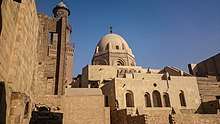
The reign of Baibars' ally and successor, Al-Mansur Qalawun (r. 1280–90), initiated the patronage of public and pious foundations that included madrasas, mausolea, minarets, and hospitals. Such endowed complexes not only ensured the survival of the patron's wealth but also perpetuated his name, both of which were endangered by legal problems relating to inheritance and confiscation of family fortunes. Besides Qalawun's complex, other important commissions by Bahri Mamluk sultans include those of an-Nasir Muhammad (1295–1304) as well as the immense and splendid complex of Hasan (begun 1356).
The Burji Mamluk sultans followed the artistic traditions established by their Bahri predecessors. Mamluk textiles and carpets were prized in international trade. In architecture, endowed public and pious foundations continued to be favored. Major commissions in the early Burji period in Egypt included the complexes built by Barquq (r. 1382–99), Faraj (r. 1399–1412), Mu’ayyad Shaykh (r. 1412–21), and Barsbay (r. 1422–38).
In the eastern Mediterranean provinces, the lucrative trade in textiles between Iran and Europe helped revive the economy. Also significant was the commercial activity of pilgrims en route to Mecca and Medina. Large warehouses such as the Khan al-Qadi (1441), were erected to satisfy the surge in trade. Other public foundations in the region included the mosques of Aqbugha al-Utrush (Aleppo, 1399–1410) and Sabun (Damascus, 1464) as well as the Madrasa Jaqmaqiyya (Damascus, 1421).
In the second half of the 15th century, the arts thrived under the patronage of Qaitbay (r. 1468–96), the greatest of the later Mamluk sultans. During his reign, the shrines of Mecca and Medina were extensively restored.[4]
Major cities were endowed with commercial buildings, religious foundations, and bridges. In Cairo, the complex of Qaitbay in the Northern Cemetery (1472–74) is the best known and admired structure of this period.
Building continued under the last Mamluk sultan, Al-Ashraf Qansuh al-Ghuri (r. 1501–17), who commissioned his own complex (1503–5); however, construction methods reflected the finances of the state.
Though the Mamluk realm was soon incorporated into the Ottoman Empire (1517), Mamluk visual culture continued to inspire Ottoman and other Islamic artistic traditions. Changes in the Ottoman architecture in Egypt include the introduction of pencil-shaped minarets from the Ottomans and domed mosques which gained dominance over the hypostyle mosques of the Mamluk period. The Sulayman Pasha Mosque from 1528 is an example of this.[5][6]
Notes
- Behrens-Abouseif 2008.
- Raymond 1993.
- Yalman, Suzan. "The Art of the Mamluk Period (1250–1517)". The Met's Heilbrunn Timeline of Art History. The Metropolitan Museum of Art.
- Bloom & Blair 2009, p. 152.
- Bloom & Blair 1995, p. 251.
- Rabbat, Nasser. "Ottoman Architecture in Cairo: The Age of the Governors". web.mit.edu. Retrieved 4 December 2018.
References
- Behrens-Abouseif, Doris (2008). Cairo of the Mamluks : A History of Architecture and Its Culture. New York: Macmillan.CS1 maint: ref=harv (link)
- Bloom, Jonathan M.; Blair, Sheila (1995). The art and architecture of Islam 1250-1800. Yale University Press. ISBN 978-0-300-06465-0.CS1 maint: ref=harv (link)
- Bloom, Jonathan M.; Blair, Sheila (2009). The Grove encyclopedia of Islamic art and architecture. II. Oxford University Press. p. 152.CS1 maint: ref=harv (link)
- Raymond, André (1993). Le Caire. Fayard.CS1 maint: ref=harv (link)
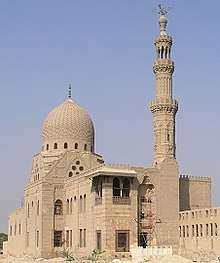


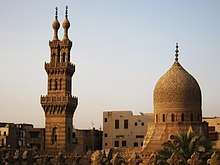
.jpg)
